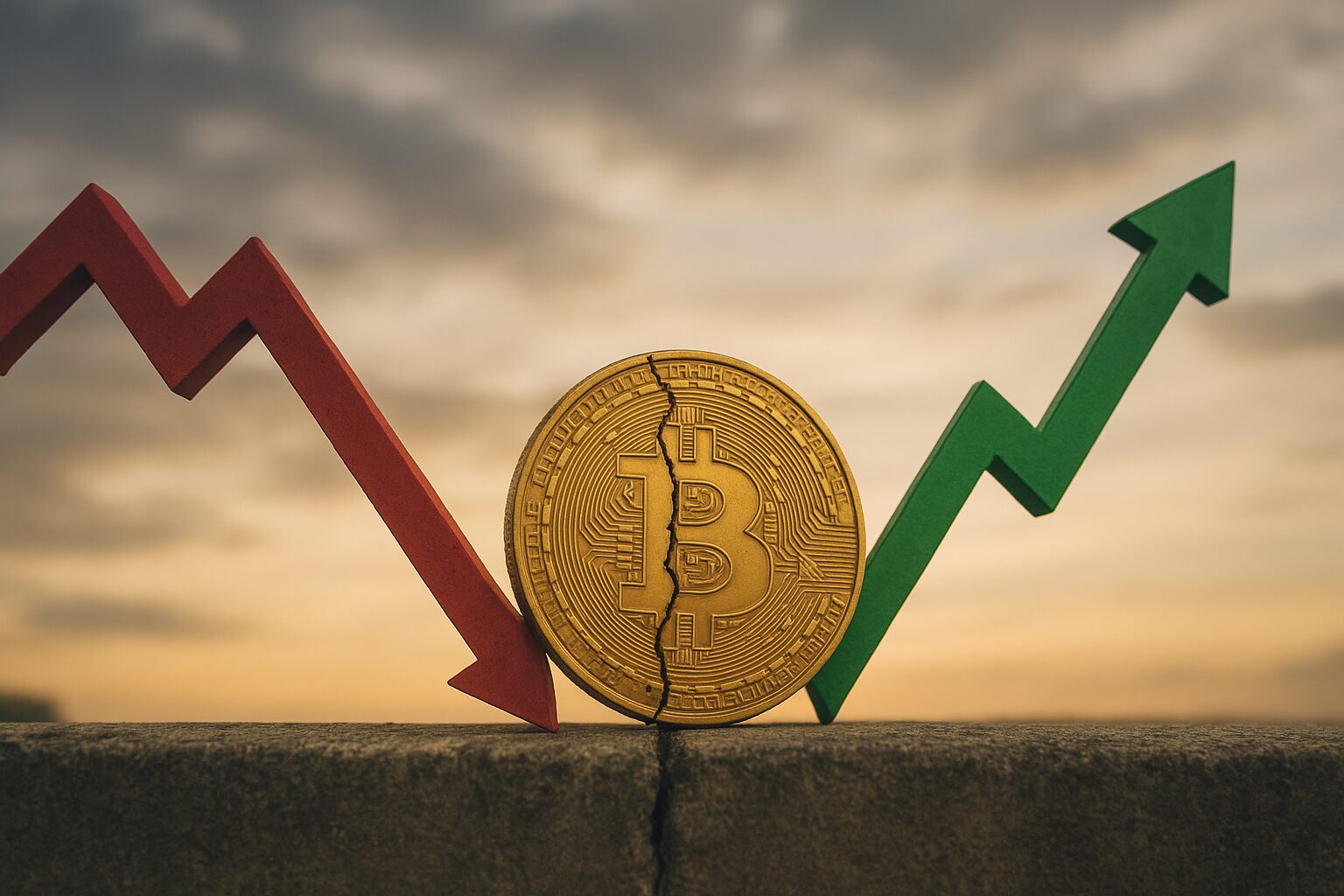The crypto market is known for its ups and downs, but when a major crypto crash happens, it can feel like the whole digital world is falling apart. Prices drop fast, portfolios shrink overnight, and fear spreads across social media and trading platforms.
Many investors panic, wondering if this is the end of crypto or just another dip before a comeback. Emotions like fear, regret, and frustration often take over, leading to rushed decisions.
But before reacting, it’s important to understand why these crashes happen and what smart investors can do next. A crypto crash is not the end of the market—it’s part of the natural cycle of volatility that every asset class experiences. Learning how to navigate it calmly can make a big difference in your long-term success.
What Is a Crypto Crash?
A crypto crash is a sudden and significant drop in the price of digital currencies—often by 20% or more within days or weeks. It’s different from a normal correction, which is a temporary dip followed by recovery.
Crypto crashes usually happen when fear spreads among traders and investors start selling off their holdings rapidly.
Historical Examples
- 2018 Crypto Winter: Bitcoin dropped from nearly $20,000 to below $4,000, wiping out most altcoin gains.
- 2022 Collapse: Triggered by the Luna/Terra ecosystem collapse, several coins and exchanges fell, causing a massive chain reaction.
These examples show how interconnected the market is—when one major project fails, it affects the entire ecosystem.
The Crypto Market Cycle
Like any financial market, crypto moves through cycles:
- Accumulation Phase – Smart investors quietly buy undervalued coins.
- Bull Market – Prices rise as more people enter the market.
- Distribution Phase – Early investors take profits.
- Bear Market (Crash) – Prices fall sharply before the next recovery.
Understanding this pattern helps investors prepare for the next rebound rather than selling at the worst time.
Key Reasons Behind the Current Crypto Crash
1. Market Overvaluation and Profit-Taking
After strong bull runs, crypto prices often become inflated. When traders start taking profits, the selling pressure triggers panic sales from others—causing sharp declines.
2. Macroeconomic Factors
Global financial conditions heavily impact crypto. Rising interest rates, inflation, or recession fears push investors toward safer assets like bonds or cash, leading to a sell-off in riskier assets like Bitcoin and altcoins.
3. Regulatory Crackdowns
Government regulations can create uncertainty. SEC lawsuits, exchange bans, or tax changes often shake market confidence. For example, when the U.S. or EU discusses stricter crypto laws, prices tend to drop as investors fear tighter control.
4. Major Project Failures or Hacks
High-profile crashes—such as FTX, Terra (LUNA), or Celsius—create distrust in the entire market. These events drain liquidity and discourage new investments.
5. Investor Panic and FUD
Fear, uncertainty, and doubt (FUD) spread quickly online. When influencers or media outlets predict a collapse, retail investors panic-sell, intensifying the crash.
6. Decline in Liquidity and Trading Volume
During downturns, fewer traders participate. Lower liquidity means prices can swing more dramatically, making crashes even worse.
How Crypto Crashes Affect Investors
A crash can test even the most experienced investors. The emotional and financial impact is real.
Portfolio Losses and Investor Psychology
Many portfolios lose half their value or more. This leads to emotional stress and rash decisions—like panic-selling at the bottom.
Impact on DeFi, NFTs, and Altcoins
- DeFi projects see lower total value locked (TVL) as users withdraw funds.
- NFT trading volume drops as collectors hold back.
- Altcoins suffer more than Bitcoin or Ethereum because of smaller market caps.
Market Sentiment
When sentiment turns bearish, even good news gets ignored. Recovery can take months or even years depending on the strength of the downturn.
What Investors Should Do Next
1. Stay Calm and Avoid Emotional Decisions
The worst thing you can do is panic-sell. Remember that crashes are temporary and part of the crypto cycle.
2. Reassess Your Portfolio
Evaluate which coins you truly believe in long-term. Focus on projects with strong fundamentals, real utility, and active communities.
3. Look for Strong Fundamental Projects
Even during a crash, quality projects continue to build. Research teams, technology, and partnerships to identify long-term winners.
4. Use Dollar-Cost Averaging (DCA)
Instead of investing all at once, buy small amounts regularly. This reduces risk and helps you accumulate during dips.
5. Hold Cash or Stablecoins
Having stable assets like USDT or USDC gives you flexibility to buy opportunities during downturns.
6. Educate Yourself
Follow reliable crypto education sites and avoid hype-driven influencers. Platforms like CoinDesk or Crypto30x.com offer trusted market insights.
Expert Insights and Data
What Analysts Say
Experts suggest that crashes are a normal reset phase. They clean out overvalued coins and pave the way for the next growth wave.
“Crypto crashes often separate real innovation from hype. Smart investors use downturns to accumulate quality assets.” — Blockchain analyst, 2025 report.
Visual Chart: Average Recovery Time After Major Crypto Crashes
| Year | Cause of Crash | Bitcoin Low | Time to Recover | Market Recovery % |
|---|---|---|---|---|
| 2018 | ICO Bubble Burst | $3,200 | 18 months | 400% |
| 2020 | COVID-19 Panic | $5,000 | 6 months | 250% |
| 2022 | Luna/FTX Collapse | $15,700 | 12 months | 320% |
Source: CoinMarketCap, Messari Research (2025)
As the data shows, crypto markets eventually recover after every major crash—though it takes patience and confidence.
Long-Term Opportunities Amid a Crypto Crash
Every crash creates room for new leaders and innovation.
1. Innovation Rises During Downturns
Bear markets often push developers to focus on real utility. Many successful projects—like Uniswap and Polygon—were built during down markets.
2. Early Investors Gain the Most
Those who bought during previous crashes (Bitcoin at $3,000 in 2018 or Ethereum at $100 in 2020) earned massive returns later.
3. Build a Future-Ready Strategy
Use the downturn to:
- Rebalance your portfolio.
- Study blockchain trends like AI integration or Layer 2 solutions.
- Prepare for the next bull run instead of chasing short-term profits.
Common Mistakes to Avoid
- Selling at the Bottom – Losses only become real when you sell too soon.
- Following Hype – Don’t trust influencers without research.
- Ignoring Diversification – Spread risk across multiple assets.
- Neglecting Security – Store your coins in hardware wallets like Ledger or Trezor.
- Overtrading – Trying to time the bottom often leads to missed opportunities.
When Will the Crypto Market Recover?
Crypto has always been cyclical. While predicting exact timelines is impossible, several signs can indicate an upcoming rebound.
Recovery Signals to Watch
- Increasing trading volume
- Positive regulatory developments
- Institutional adoption or ETF approvals
- Rising on-chain activity (new wallet growth, active addresses)
Historical Patterns
Past data shows recovery typically happens 6–18 months after a major crash, depending on external conditions like interest rates and innovation cycles.
Expert Predictions
Analysts from top firms expect the next bull cycle between late 2025 and 2026, driven by blockchain adoption, AI integration, and clearer regulations.
Conclusion
A crypto crash can feel devastating, but it’s part of the long-term market rhythm. Each downturn helps remove weak projects and prepares the market for stronger, more sustainable growth.
The key for investors is discipline and perspective—stay informed, hold quality assets, and use the time to prepare for the next rally.
Remember, the market rewards patience, not panic.
FAQs
1. What causes a crypto crash?
A crypto crash happens when large sell-offs, bad news, or economic factors trigger widespread panic and sharp price drops.
2. How long do crypto crashes usually last?
Typically, they last between 6 to 18 months before recovery begins, depending on market sentiment and global conditions.
3. Is it smart to buy during a crypto crash?
Yes, but only after researching solid projects. Buying during dips can yield high returns long-term.
4. Which coins recover fastest after a crash?
Generally, Bitcoin, Ethereum, and coins with strong fundamentals recover faster than smaller altcoins.
5. How can beginners protect their portfolios during a downturn?
Diversify holdings, use dollar-cost averaging, and avoid emotional trading.
6. What signs show a crypto recovery is starting?
Rising trading volume, new exchange listings, and institutional interest often signal a comeback.
7. Should I sell or hold during a crash?
If your projects have strong fundamentals, it’s usually better to hold and avoid panic-selling.
8. Is the crypto market crashing permanently?
No, history shows crypto always recovers and evolves after each major crash.
9. How do global events affect crypto prices?
Events like inflation spikes, wars, or tech regulations can reduce investor confidence and liquidity.
10. What’s the safest way to invest after a crash?
Focus on established projects, use secure wallets, and follow a consistent investment strategy like DCA.
Disclaimer
This content is for educational purposes only and should not be considered financial advice. Cryptocurrency markets are volatile, and investing carries risks. Always conduct your own research or consult a financial advisor before making investment decisions.



